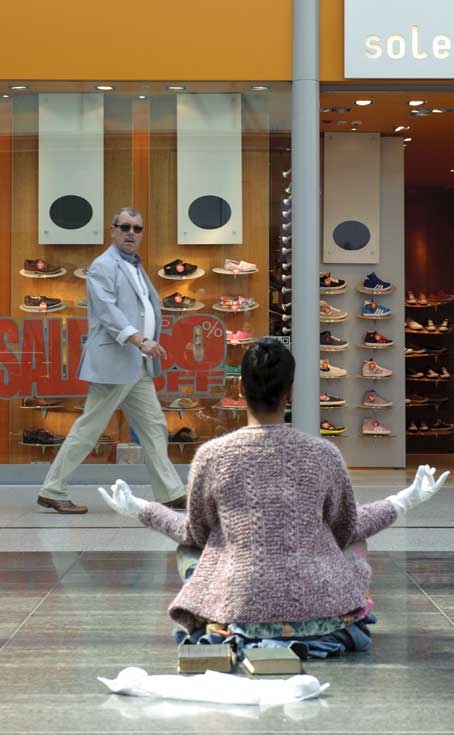On a bridge inside Manchester’s colossal Arndale centre two attractive young performers are interpreting Theaster Gates’s instruction-work How to Catch the Holy Ghost or Get Arrested in a Shopping Mall (2012), an offsite event for the Hans Ulrich Obrist-curated Do It exhibition, part of the Manchester International Festival.
The man is earnestly struggling to repeat a line – a bit of a tongue-twister – from a church hymnbook: “With souls refresh”. Gates’s directions for an impromptu sermon encourage you to “open your heart” and “feel something”, but it’s a tough call in the soulless surroundings of one of Britain’s first ‘US-style’ shopping malls, especially for an arty crowd anyway disdainful of bland chain-stores. Security guards look on, bored; there’s no threat of arrest here.
Do It provides a continuum through Obrist’s curatorial career, a symbol of his relentless energy, obsessive networking and more-is-more philosophy
Do It 2013 marks the 20th anniversary of Obrist’s generative exhibition project, conceived with artists Christian Boltanski and Bertrand Lavier, which consists of an ever-expanding collection of artists’ instructions from which institutions are invited to curate their own customised displays. There have been over 100 official installations, as well as TV and online incarnations, and countless unrecorded home versions.
The version hosted by Manchester Art Gallery was developed with Peter Saville and Richard Wentworth, a coupling that explains why the design of the show is an odd but likeable mix of slick graphics (instructions stencilled in large font on the wall of the main gallery) and DIY support structures, such as Wentworth’s clunky viewing ramp, which also doubles as a display platform for piles of A4 take-home instructions.
If the idea to unreservedly just ‘do it’ à la the Nike slogan seems very un-British in the Arndale, there are fewer inhibitions in the gallery, particularly in the Active and Games rooms, where visitors are actively encouraged to participate in the works. In fact, Do It 2013 feels like an experiment in just how much participation it is possible to generate (artist–artist/ visitor–artist/visitor–visitor) before an institution collapses into complete chaos.
In the foyer, a toy poodle sits patiently on a podium, while later a live vulture is set loose in the main gallery
Everywhere you look, from toilet to lift to in among the permanent collection, there are yet more instructions, as if they are multiplying virally. The main space stinks of fried shrimp paste, as a volunteer cooks up Rirkrit Tiravanija’s recipe instruction. In the foyer, a toy poodle sits patiently on a podium, while later a live vulture is set loose in the main gallery. A team of ‘cleaners’ in red T-shirts branded ‘Sweeping… continuing daily’ sweep coloured slips of propaganda around the galleries, making visible the immaterial labour of institutions. This is Suzanne Lacy’s activist interpretation of Allan Kaprow’s original instruction, one of several artists’ homages to artists who have died since the project began.
Do It connects to a wider history of artists’ instructions throughout the twentieth and twenty-first centuries, and for Obrist it also provides a continuum through his curatorial career, a symbol of his relentless energy, obsessive networking and more-is-more philosophy. It is a project that shows an unusually uncynical side to the artworld – generous, witty, touching and surprising. Nonetheless, Do It is a paradox: a project that both challenges artistic authorship, and thus the economy of original objects, yet leans heavily on the currency of celebrity art brands (not least Obrist’s) and their ever-expanding global distribution.
This article originally appeared in the October 2013 issue.
